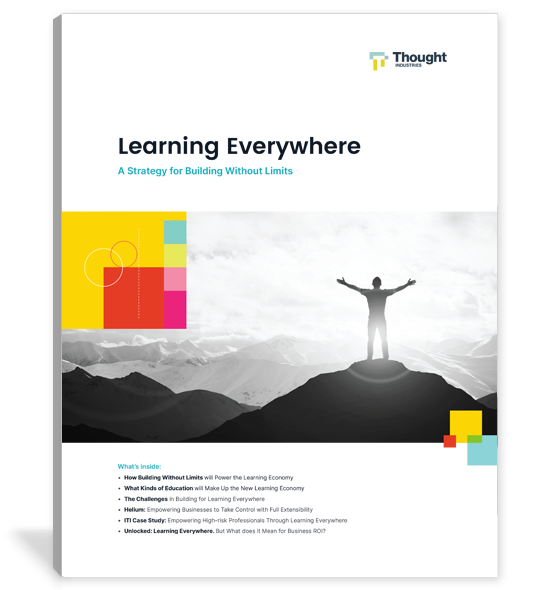No doubt about it, education and learning is an exciting industry to be working in right about now. The opportunities to deliver learning in a multi-modal, cross-channel, personalized and direct way are closer than ever before. To make these learning experiences a reality, LMS extensibility and customization are key.
We’re so passionate about the topic – we wrote this whitepaper about it! Want an overview before you dive in? We’ve got you covered.
Why Can’t I Build and Customize Learning with Existing Tools?
Today’s training and learning professionals have 99 problems, and generic learning experiences are most certainly one.
Existing LMS tools weren’t built for the wide range of needs of today’s instructional designers and developers, because they weren’t built for the extended enterprise at all. Most LMS solutions were designed for corporate and internal L&D training, not for customers or channel partners, and certainly not for immersive, engaging learning experiences.
As a result, they are:
- Limited in production capabilities: Instructional designers are pushing themselves to create ambitious and exciting learning opportunities, but developers can’t get that vision translated accurately from the white board to the product.
- Lacking in design freedom: Shouldn’t your learning look like the picture in your head? Many LMS tools are one-size-fits-all, but your learners have their own specific needs. Templates won’t cut it anymore, but that’s what existing tools offer as standard.
- Impossible to glean data insights from: Data means nothing if it lives in a silo. LMS data is awesome, and can tell you a lot about the learner experience. How about when you’re ready to analyze it side by side with data from Support, Sales, Marketing, and more? If the answer is blank stares – your LMS isn’t cutting it.
- Tough to integrate with: It would be great if one technology could solve all your problems, but the software world has yet to recreate chocolate in a platform. That means your tools need to play nicely. Integrations with third-party systems can be lengthy and complex (or even impossible) with a legacy LMS.
- Living in the past: Where will your customers and partners be learning tomorrow? It could be via IoT devices, on AR or VR, or perhaps on a device we haven’t heard of yet. Design and implementation teams need total freedom to build anywhere, so that learners can do the same.
Understanding these market challenges, we built our headless LMS, Helium, offering ultimate design freedom, total extensibility and complete control.
What is Helium? A Closer Look into LMS Extensibility
The idea of a headless LMS is that the back-end services are entirely decoupled from the front-end presentation layer.
For those who don’t speak tech, that means you get a foundational LMS solution with powerful back-end functionality, but the front-end user experience can be exactly what you want it to be, and can be extended out to any and all channels and devices.
You choose the look and feel, pick your branding and learning experience, and push it out into the world via whichever delivery channels make sense for your business.
What Does Helium Include?
When we built Helium, we wanted to deliver that perfect sweet spot of enough hand-holding and support, without any of the rigid boundaries that keep you tied to our vision or release cycles, instead of your own.
Ultimate design freedom means just that, but we want to make it simple for you. That’s why to build your learning experiences, you can access a complete library of UI components, hooks and utilities. Our back-end services are JavaScript library, React, Tailwind CSS which is a smart styling and design framework, and GraphQL for data management and control.
Reach out to schedule a demo of Helium, and we’d be happy to show you how it delights in greater detail.
What’s Possible with an Extensible LMS?
An extensible architecture is by nature designed to accommodate customization and change, which means design and development teams can:
- Take control of the picture in your head: Personalize at will to achieve any design vision, including niche use cases or specific customer needs.
- Tweak to your heart’s content: Modify the structure, appearance and functionality of learning content. And then modify it again.
- Use data to its full potential: Uncover the power of external data sets when aligned with LMS data. Measure performance and prove impact.
- Keep the baby, and the bathwater: Your home-grown systems don’t deserve the ditch. Integrate the new learning experience with your existing tech stack.
- Grab hold of the future of learning: Customize and deliver beyond web and HTML, multimodal, multi-channel, and in the moment of need.
Want more information on how to build without limits? We can’t get enough, either! Read the full whitepaper to learn:
- Field training, product installation, simulations, and more. Examples of the kinds of learning that will make up tomorrow’s $70B learning economy.
- How Industrial Training International saw 260% overall sales growth and an increase of 520% in subscriptions with Thought Industries Learning Hub.
- The route to C-suite buy-in. 6 ways to describe the need for a Headless LMS to your boss.
Download the white paper below, and reach out to schedule a demo of Helium.





